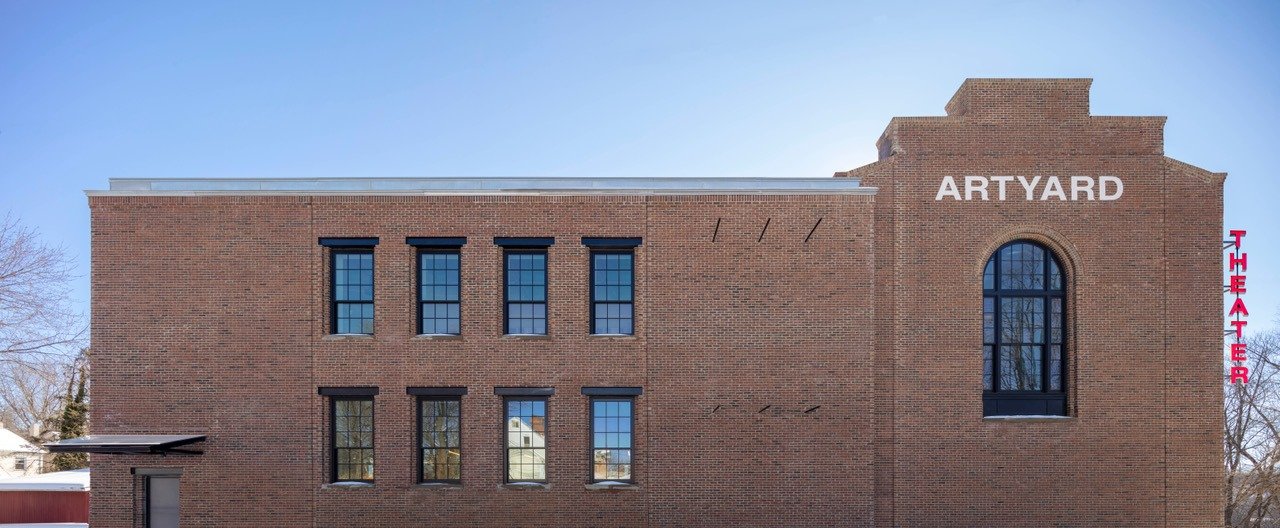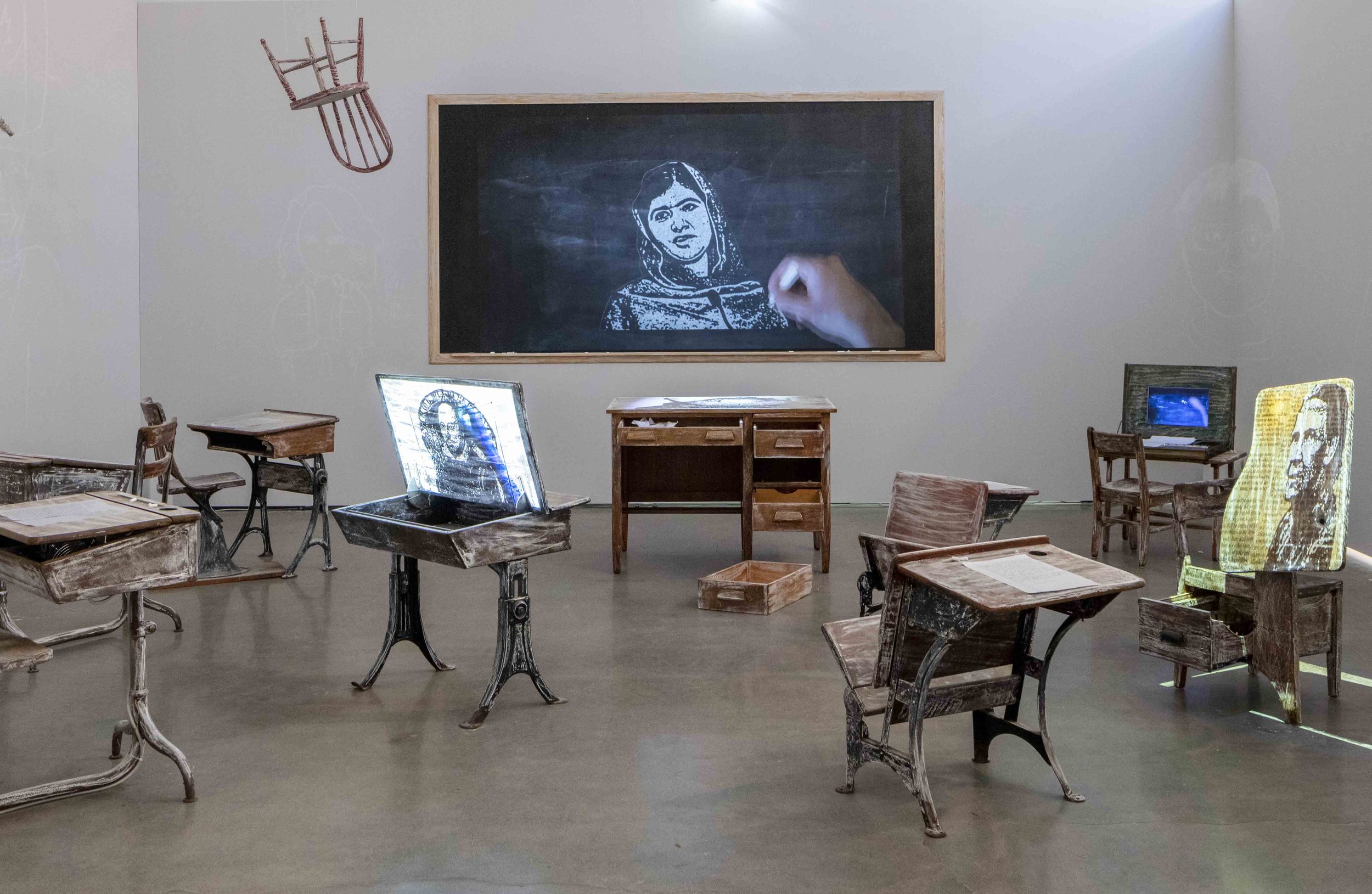Arts Utopia in Frenchtown
With exhibitions, performances, residencies, and workshops, ArtYard welcomes the chance to make sense of an otherwise senseless world
What first made Invisible visible to me were artist Vasiliki Katsarou’s posts about her installation, in which gumball machines dispense haiku poems on fortune cookie-sized pieces of paper. Invisible – besides being the state of eluding observation – is an exhibition at ArtYard in Frenchtown (on view through April 10) that looks at “omitted histories and unspoken narratives” through the work of 12 artists.
Vasiliki Katsarou’s Invisible Poems, on view at ArtYard
Katsarou, a published poet and filmmaker, offers participants – who open little plastic capsules to read the haikus – the additional opportunity to drop the short poem into a jar of water and watch it slowly dissolve, the paper disappearing as the text lingers just a bit before it ultimately dissipates. Like the inspiration that brings them about, poems in Katsarou’s exploration are ephemeral.
“As a filmmaker, I've altered and filled spaces in the real world to convey the imaginative spaces I held in my mind,” says Katsarou, “and this installation is another instance of the same impulse, but where the viewer becomes participant and sets the whole scene in motion. I'm grateful for this new opportunity to put my poetry into dialogue with visual art.”
This was my first visit to ArtYard in its glistening new space at 13 Front Street. In the Before Times, I’d dropped in to see intriguing exhibitions and performances in the location on Trenton Avenue, adjacent to Lovin’ Oven, and where writer Elizabeth Gilbert and her ex-husband once sold Indonesian home furnishings. The building includes a theatre space, offering dance, film, and music performances.
Before establishing ArtYard, founder and executive director Jill Kearney had produced collaborative theatre, dance, and literary events in her Bucks County, Pa., barn. The new building, years in the making, opened in spring 2021, just before Delta and Omicron forced many back into our hobbit holes. But oh what a space it is!
Natalija Vujosevic’s Rome
Invisible, curated by Kearney, is an exhibition of the caliber one expects to see in the finest contemporary art museums. In truth, anything would look spectacular in this former egg hatchery, reimagined as an arts center by architects William Welch and Edward Robinson, with cavernous spaces and windows overlooking the Delaware River.
“Art is an essential tool for making sense of… the absence of sense,” Kearney wrote in an essay. “It is a compass, a spade, a magnifying glass. When art is really good, I find, I imagine for a moment that I have made that artist’s thing, or written that writer’s poem, not because I am a thief or plagiarist, but because I recognize myself in the other and I forget for a moment my separateness. This is one of life’s most delicious pleasures and consolations.”
Kearney, who has degrees in English and creative writing from Harvard, has been a journalist, editor, writer, and movie executive (she also lists waitress and chambermaid on her bio), and has curated empathic exhibitions with a focus on the environment, perception, memory, selfie culture, and artists with disabilities. Her creative parents ran an arts center in Chicago that provided the inspiration for ArtYard, and the gallery space has been named for them.
Walking around the new building, and learning from the website that the ArtYard campus includes numerous other architecturally significant buildings in Frenchtown, including the stately Victorian at 12 Bridge Street with artist residencies, poetry reading rooms, installation spaces, artist workshops, and “communal festivities,” one can’t help but wonder, “where’d they get all the money?”
Kearney is married to “Sausage King” Stephen McDonnell, who founded Applegate Farms, maker of nitrate-free smoked meats. After a stroke in 2014, McDonnell sold the company to Hormel for $800 million, according to an article in the New York Times. This helped provide seed money for ArtYard, which, in 2015, incorporated as a 501(c)3 non-profit arts center.
Kawita Vatanajyankur’a videos about the invisible labor of women.
But back to Invisible. On the first floor are several videos by Thailand-based artist Kawita Vatanajyankur that depict with pathos the invisibility of women. In one, a scantily clad figure shuttles her body through a loom, pulling through a single thread that is both part of her garment and the woven work – she has to personally unravel in order to create her work. In another, an inverted woman’s body becomes one with a dustpan, as her hair sweeps the floor. In yet another, her inverted body is pulled down by a set of hands to dunk her hair into a vat of red liquid – like spaghetti in sauce. These, and others, point to the absurdities of so many tasks women have been expected to fulfill.
New Jersey-based artist Willie Cole, whose iconic works incorporate irons, has several prints in Invisible that are portraits of beloved women in his life, cast as weathered ironing boards whose shapes evoke maps of slave ship holds.
Sandra Ramos’ dystopian classroom
While some artists come from as far away as Montenegro and Mexico, Cuban artist Sandra Ramos worked with Frenchtown schoolchildren to create a dystopian classroom. Six video projectors play on vintage school desks, blackboards, floor and ceiling, while teachers’ chairs hang askew. We see images of Nelson Mandela, Anne Frank, and other historical figures, drawn by hand in chalk, then quickly erased. The installation questions the teaching and erasing of certain aspects of history. It is accompanied by a soundtrack by Pavel Urkiza of chalk on a chalkboard.
Do spend the time to read the handwritten essays on the school desks – one is about “a famous Frenchtown local who has special needs” and, though orphaned, brings good cheer to children who call him the mayor of Frenchtown.
sTo Len’s River Scroll (for Frenchtown)
sTo Len has several monumental works of invisibility, including a primitive dugout canoe filled with detritus from the Delaware. It was created while Len was in residency at ArtYard, from “a series of mud larking expeditions to forage for river born refuse.” He is presently artist-in-residence at the New York City Department of Transportation. While not exactly making refuse invisible, Len’s art is bringing our focus to the problem of refuse.
“The idea for Invisible germinated when I stumbled on the videos of Kawita Vatanajyankur at the Albright Knox Museum in Buffalo, New York,” says Kearney. “Kawita’s work makes visible the invisible labor of women. I felt that I had been seen, somehow, in fact, by a total stranger. Kawita captured and distilled in these images the beauty, humor, inequity, fragility, ugliness, and tenderness of this life. Art is an antidote to the loneliness of human existence. To be seen is everything.”
Invisible is on view through April 10, and features the work of Monica Banks, Willie Cole, Phebe Macrae Corcoran, Vasiliki Katsarou, sTo Len, Kaitlin Pomerantz, Kelly Popoff, Sandra Ramos, Gabrielle Senza, Pavel Urkiza, Kawita Vatanajyankur, and Natalija Vujošević. ArtYard is located at 13 Front Street in Frenchtown, in the Delaware River Valley. For more visitor information and more, please visit ArtYard.org.
Images in header include photos from Invisible’s opening night, including a shot with Jill Kearney and some of the exhibit’s artists and two of guests interacting with Vasiliki Katsarou’s works, all by Laura Billingham; an installation shot of Willie Cole’s Beauties; and a photo of ArtYard’s facade.










